Dr. Phil Zeltzman’s Blog
Killing with kindness…
The survey is out. Unfortunately, I have some discouraging results to share. Despite the amount of education provided, the campaigns, the warnings, the all-natural foods, the grain free diets, and all kinds of other diet fads, pet overweight is more and more common, year after year. The results of a recent survey showed that 60% of our cats and 56% of our dogs were overweight in 2017.

These results are provided by the Association for Pet Obesity Prevention (APOP) (www.PetObesityPrevention.org), a non-profit created by my colleague Dr. Ernie Ward in 2005 (full disclosure: I’m a member of the board – only because I am passionate about this topic. Oh, and because I wrote a book about it. More info below).
There are many reasons for this growing trend, including too much food, too many treats and not enough exercise. Therefore, the solutions are pretty easy: fewer calories and more activity. Easier said than done…
Meanwhile, excessive weight in pets:
. puts unnecessary strain on the joints.
. increases the risk of heart disease.
. increases the risk of diabetes.
. increases the risk of some tumors and cancers.
. increases the risk of many other preventable diseases.
. dramatically decreases your pet’s quality of life.
. reduces a dog’s lifespan by an average of 2 years!!!
Over 50 % of those surveyed (veterinary professionals and pet owners) were interested in weight loss in their pets or patients, but did not achieve results due to various reasons. Those reasons included time constraints, physical limitations (of the pet or the owner), behavior issues or limited access to exercise areas.
There was a great disparity amongst the opinion of veterinarians and pet owners about what ingredients are good for pets. Veterinarians predominately agreed that corn was an acceptable ingredient but grain free and raw diets were not (please hold the hate email, I am only sharing results of a survey here).
Owners in the survey believed corn was not good for their pets but believed grain free was healthier. They were unsure about the health properties of raw diets. Both owners and veterinarians agreed that commercial diets have improved over the last 10 years.
Veterinarians and their support staff have an integral role in combating overweight pets, yet fewer than 50% of pet owners were given food recommendations. Veterinarians confirmed this: only 50% surveyed said they provided dietary recommendations.
Owners surveyed received approximately 50% of their dietary recommendations from veterinarians and 50% from Internet searches.
So what’s the moral of this story?
A few important points:
. Learn how to assess if your pet is overweight with the help of your veterinarian. There is about a 60% chance that he or she is.
. Do not attempt weight loss or weight management without assistance from your veterinarian. The overall health of your pet contributes to his or her weight and there may be an underlying disease that requires medical treatment.
. Don’t listen to the hype. Many pet diets are promoted by brilliant marketing specialists, but that’s where their expertise stops. Your veterinarian will help you pick a diet that meets your pet’s specific needs, with the research and quality control to back it up.
. “Light” or “restricted calorie” diets are not appropriate for weight loss. I see that all the time in my patients. However, they are great to maintain the weight after weight loss.
. In my mind, all neutered or spayed cats and dogs should be on a “light” diet to prevent weight gain because their metabolism slows down after the surgery and makes them prone to being overweight.
. Many dedicated pet owner home cook for their pet. I get it. However, it is extremely difficult to create a balanced diet at home. There are countless nutrients, vitamins and minerals that are needed in small quantities. Serious pet food companies spend a fortune calculating the right amount of different ingredients to create balanced diets. Use them to your pet’s benefit.
. Most of our pets cannot survive on a vegan diet. It will severely harm them.
. Grain-free diets have recently been linked to heart disease (DCM or Dilated Cardio-Myopathy). So much for a healthy diet… (read more here: https://vetnutrition.tufts.edu/2018/06/a-broken-heart-risk-of-heart-disease-in-boutique-or-grain-free-diets-and-exotic-ingredients/)
. Do not starve your pet for the sake of weight loss. Cutting the portion in half and experiencing a rapid weight loss can endanger your pet. And it can kill a cat. A slow, gradual, weight loss is very important and should be supervised by your veterinarian.
. Your vet can suggest creative ways to provide exercise despite your physical and spatial limits.
Weight loss for your pet can be difficult to achieve, but it will be well worth it for the comfort and longevity of your pet.
Incidentally, I wrote a book about weight loss… called “Walk a Hound, Lose a Pound” (How You & Your Dog Can Lose Weight, Stay Fit, and Have Fun), you can find it by following the link below.
https://www.amazon.com/Walk-Hound-Lose-Pound-Human-Animal/dp/1557535817
Bottom line: pet lovers have a huge responsibility in the health of their pet, which includes their weight. Please help your pet have a healthy weight.
Phil Zeltzman, DVM, DACVS, CVJ, Fear Free Certified

Dr. Phil Zeltzman is a traveling veterinary surgeon in Pennsylvania & New Jersey. An award-winning author, he loves to share his adventures in practice along with information about vet medicine and surgery that can really help your pets. Dr. Zeltzman specializes in orthopedic, neurologic, cancer, and soft tissue surgeries for dogs, cats, and small exotics. By working with local family vets, he offers the best surgical care, safest anesthesia, and utmost pain management to all his patients. Sign up to get an email when he updates his blog, and follow him on Facebook, too!
Why did Phoebe need a nose job?
Phoebe is a 3 year old bulldog who was struggling to breathe. Her breathing was very loud and harsh. She couldn’t function without panting. She snored while sleeping. Was easily overheated.
Things got progressively worse and she was nearly suffocating. She was taken to the emergency clinic where she was sedated to place a breathing tube to allow her to calm down, lower her temperature and get her oxygenation up to normal.

All Bulldogs (French, English), Boston Terriers, Pekinese, Boxers and Pugs are called brachycephalic breeds (which means “short skull”). They have a short snout and a flat face. Not all brachycephalic breeds have brachycephalic syndrome, but it should be suspected until proven otherwise.
Brachycephalic syndrome usually has three parts:
. An elongated soft palate, which means that the back of the roof of the mouth is so long that it covers the opening to the windpipe.
. Saccules are fleshy structures at the opening of the airway. When brachycephalic breeds have difficulty breathing, over time, the saccules are mechanically pulled out into the airway.
. Stenotic nares are smaller nostrils than normal, which again prevents getting enough oxygen.
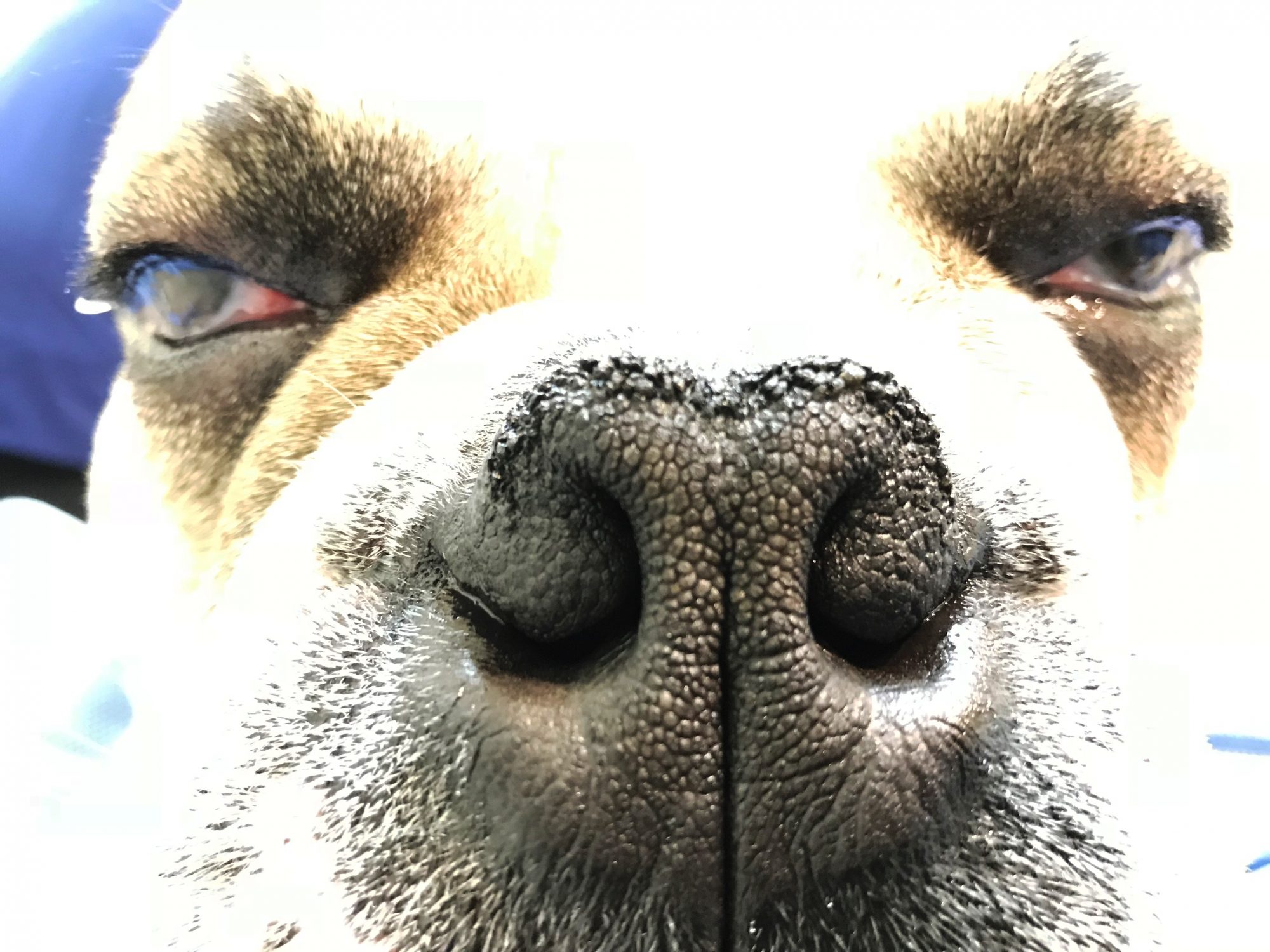
Notice the tiny openings before surgery
There is at least one more issue: Bulldogs, in particular, have a tiny windpipe. There is nothing we can do about it, but it certainly doesn’t help these dogs breathe.
We can however fix all 3 issues mentioned above.
Phoebe needed all 3 repaired:
. Her elongated soft palate was shortened.
. Her “everted” saccules were removed.
. Her almost non-existent nostrils were widened.
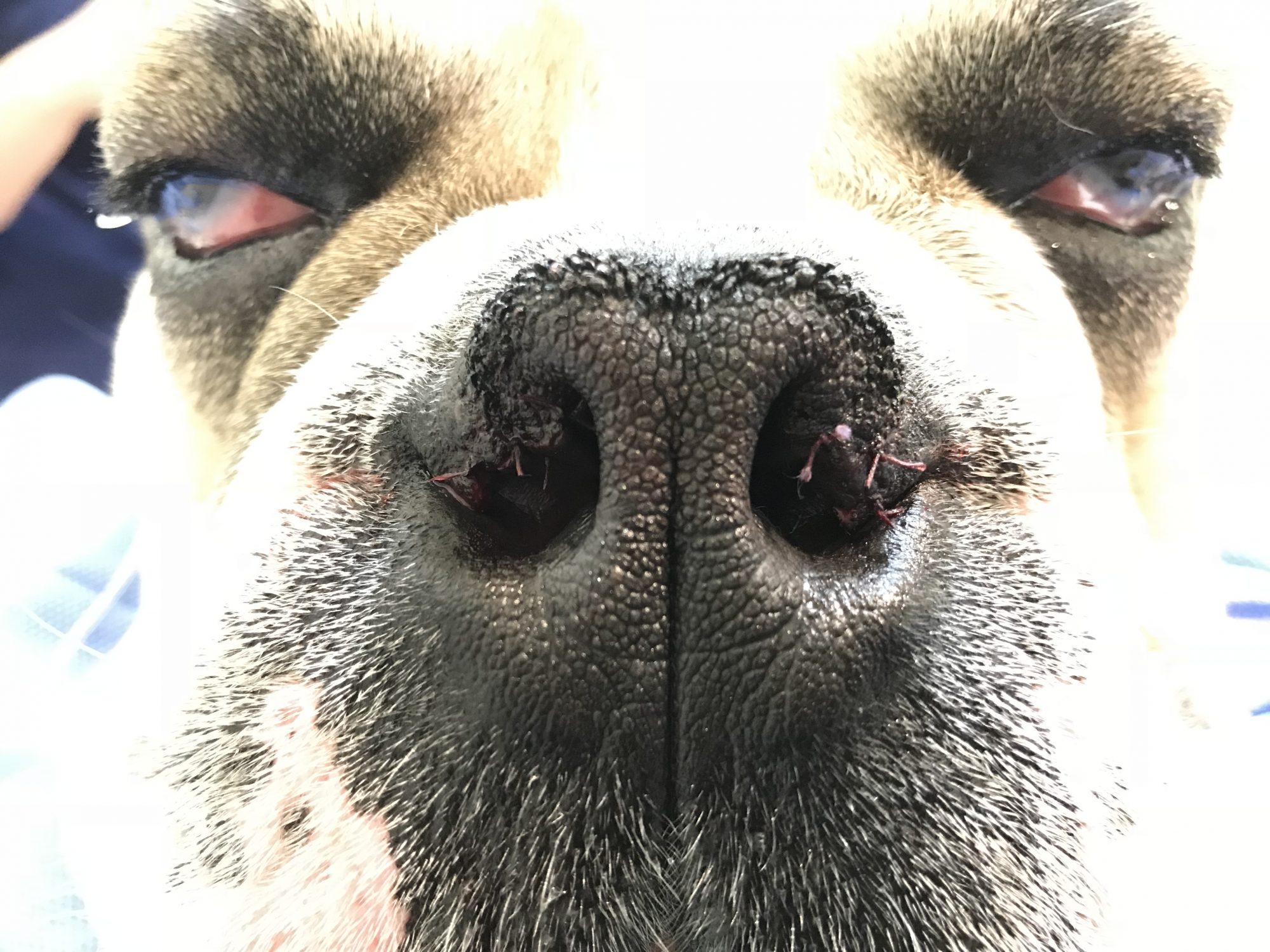
Notice the much wider nostrils after surgery
Some surgeons recommend doing a nose job on brachycephalic puppies as early as 3 to 4 months of age. Why so young? Because we hope that if we fix the nose at that age, and the dog doesn’t struggle to breathe, the soft palate and saccules may remain pretty normal.
So we feel that it’s better to widen the nostrils at a young age, which is not very invasive, than to do the full 3 surgeries at a later age. At that point, there are many other additional changes that we simply cannot repair.
While the pup is under anesthesia, we also recommend doing a spay or a castration. This is a great way to prevent spreading the bad genes to future generations, among many other benefits.
Phoebe recovered very well after surgery. She was able to breathe much better by day and stopped snoring at night. Ironically, it also helped her owners sleep better at night.
Phil Zeltzman, DVM, DACVS, CVJ, Fear Free Certified

Dr. Phil Zeltzman is a traveling veterinary surgeon in Pennsylvania & New Jersey. An award-winning author, he loves to share his adventures in practice along with information about vet medicine and surgery that can really help your pets. Dr. Zeltzman specializes in orthopedic, neurologic, cancer, and soft tissue surgeries for dogs, cats, and small exotics. By working with local family vets, he offers the best surgical care, safest anesthesia, and utmost pain management to all his patients. Sign up to get an email when he updates his blog, and follow him on Facebook, too!
Do you make New Year resolutions for your pet?
Do you make New Year resolutions for yourself? How about for your pet(s)?
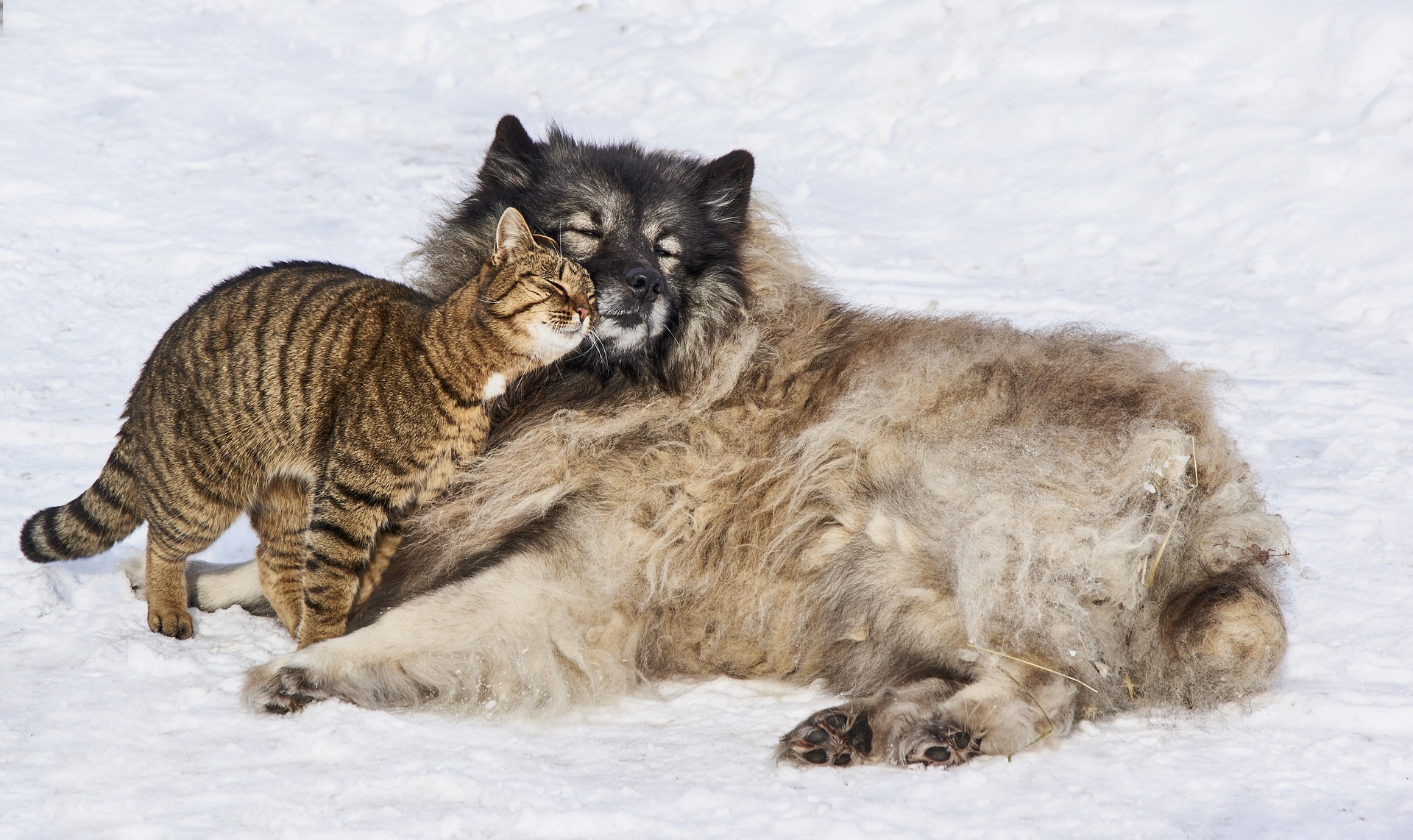
Here are a few simple suggestions to get you started… and to help your pet(s) live a happier, healthier, longer life.
1. Taking your pet to the vet once a year is outdated
Health experts now recommend a checkup every 6 months, especially in senior pets. The goal is to detect health issues earlier. How so?
For example, it is not unusual for my referring vets to find a mass in the skin or worse, in the belly (on the spleen or the liver for example) during a “routine” physical exam. Whether the mass is benign or malignant, the sooner it is removed, the better for your pet.
2. Keep your pets up to date on vaccines
Please don’t fall into the “my pet never leaves home” trap. If your pet ever needs emergency care or surgery, (s)he could catch a contagious disease at the hospital.
Plus, rabies vaccination may be required by law where you live.
3. Stay on top of dental care
It’s not just a matter of bad breath. It’s also a way to prevent tooth decay, loss of teeth, severe pain, and infection spreading to the heart, the liver and the kidneys.
4. Take parasite control seriously
Parasites can be both internal (ie intestinal worms and heartworms) and external (ie fleas and ticks). You would be surprised to know how many pets which end up on my surgery tables have fleas! And no, they did not catch them at the hospital!
5. Keep track of your pet’s medical history
It doesn’t need to be fancy. A simple notebook will do. I am always surprised when I ask simple questions about a pet’s medical history and the owner answers: “I don’t know.” You owe it to your pet!
If you don’t understand something, please ask your vet or the nurse. That’s what we’re there for.
6. Medications are prescribed for a reason
Please give them as directed. Finish the full course, especially antibiotics. Don’t give them to another pet without being directed by your vet. Even better, please don’t give any medication not approved by your vet, especially people medications, starting with aspirin and Tylenol.
7. Keep your pet thin
Chubby pets are at risk for a number of diseases, and die on average 2 years earlier than thin pets.
8. Keep your pet on a leash
Keep the collar snug. Use pet identification (a microchip under the skin is a simple and reliable solution). Don’t let your pet get hit by a car.
9. Spay or neuter your pet
When done before 6 months of age, spaying a female pet virtually eliminates the risk of breast cancer and totally eliminates the risk of infection of the uterus (pyometra).
Neutering eliminates or dramatically reduces the risk of many diseases (prostate conditions, testicle problems, perineal hernia etc.).
10. Get pet insurance
An embarrassingly large number of pets is euthanized every year because their owners simply can’t afford the life-saving treatment they need. It is so sad, especially when a good pet insurance plan could have saved these lives (beware, there are some very bad plans out there).
11. Pet proof your house
Especially be careful in “at risk” rooms: kitchen, bathroom, garage. There are countless poisons throughout the house, so store them in locked cabinets. Also ban toxic plants from your house.
12. Cats love playing with strings or ribbons
They will sometimes even swallow them. They can be deadly as they cut through the intestine. Dogs are not immune to this common problem!
13. Exercise with your pet
Even if it’s just a daily walk, it’s good for both of you, and it is great to bond with your pet. If you have a cat, playing with a laser is an easy way to provide lots of fun – for you included!
14. “Pet your pet” often
This will help you notice skin lumps and bumps early. And please do not procrastinate to have them tested or removed.
15. Every pet should have some manners
Dogs should have some basic obedience and should know a few rules (“Don’t bark frantically in an exam room”, “Don’t bite the nice doctor”), and should know that you are the boss. You are, right?
If you’re not sure, ask your family vet, a veterinary behaviorist or an animal behavior consultant (www.iaabc.org).
Cats can also learn an amazing number of things.
16. Consider saving a life this year
Adopt a cat or a dog from your local shelter, Humane Society or occasionally your vet.
17. People food is for people!
Feed pet food to pets! Choose a quality, balanced, reputable brand. I recently talked to a little old lady with a grossly obese Chihuahua who insisted that she only feeds 1/8 cup to her dog daily. “That’s it, Doctor, I swear.” And of course, also some treats, half a banana, some cookies, some chicken… and some ice cream.
And how about Oz, the Lab with laryngeal paralysis who weighs 140 pounds?
And Titus, the 250 pound Mastiff who needed a TPLO on both knees to address his ACL tears? The list could go on…
18. Don’t “kill with kindness”
Rather than more food, all your pet really needs from you is more time and more love. If your pet stares at you “with those irresistible eyes,” resist the urge to share food.
Instead, share a kiss or a big hug!
19. Stay informed
There is a lot of junk on the Internet. Often bad advice. Sometimes quite dangerous. Beware of Dr. Google and self-proclaimed know-it-alls and fake specialists. You owe it to your pet to stay informed.
My web site, www.drphilzeltzman.com is a good start.
20. Pets can help you live longer!
Watch this 2 minute long video. It’s an incredible testimonial about pets from a cancer physician at the Mayo clinic.
https://www.youtube.com/watch?v=GKMpUyddFyo
I sincerely wish you, your family and your pet(s) a very happy, healthy and peaceful New Year.
Let’s make it a great year!
Phil Zeltzman, DVM, DACVS, CVJ, Fear Free Certified

Dr. Phil Zeltzman is a traveling veterinary surgeon in Pennsylvania & New Jersey. An award-winning author, he loves to share his adventures in practice along with information about vet medicine and surgery that can really help your pets. Dr. Zeltzman specializes in orthopedic, neurologic, cancer, and soft tissue surgeries for dogs, cats, and small exotics. By working with local family vets, he offers the best surgical care, safest anesthesia, and utmost pain management to all his patients. Sign up to get an email when he updates his blog, and follow him on Facebook, too!
Why do we do what we do? (Part 2)
Have you ever wondered why vets and their nurses do what they do?
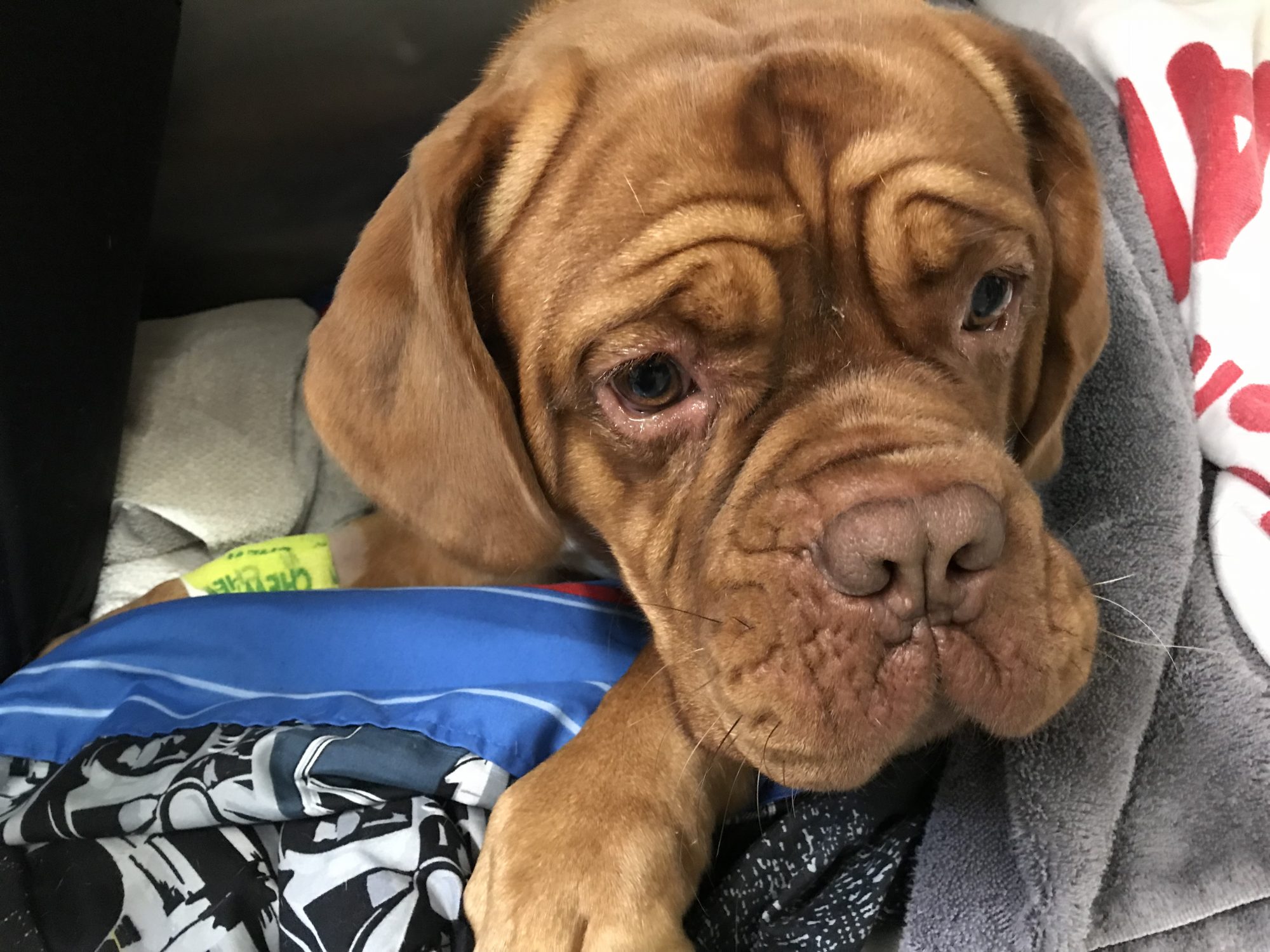
Ruby, a 2 year old Dogue de Bordeaux, wakes up from anesthesia after a TPLO to address a tear of her ACL
Last week, we described 5 things we do around surgery time, and why we do them
This week, we share 5 more features we provide routinely to your pet during anesthesia and surgery.
6. Why do we place a tube down the throat?
It’s not just down the throat, it’s into the windpipe, so that oxygen and anesthetic gas can be delivered to the lungs.
Interestingly, anesthetic gas is so powerful (yet safe) these days, that with the proper pain medications on board, we can often get by with only 1 or 2% anesthesia gas and 98 or 99% oxygen.
The tube allows us to have control of the patients breathing. So for example, we can breathe for the patient or “give a breath” if the patient doesn’t take enough oxygen in, or keeps too much CO2 in.
7. What do we monitor during anesthesia?
Monitoring a patient allows us to make anesthesia as safe as humanly possible. Depending on the sophistication of the hospital, we monitor multiple values, including:
. Temperature
. Heart rate
. EKG
. Blood pressure
. Oxygen level
. CO2 level
8. Why do we monitor anesthesia?
100% of the clinics I do surgery at have a dedicated anesthesia nurse, whose only job is to monitor the patient and make sure anesthesia is as safe as possible (if you read between the lines, this means that not all clinics take that precaution…).
Why does a nurse monitor a patient under anesthesia?
To make sure that the patient is sleeping soundly, and that the numbers on the anesthesia monitor are what they should be. Besides the monitor, nurses check on the patient. They check on the color of the gums, the depth of the anesthesia, the pulse, the breathing etc.
9. What’s the end result of monitoring?
Monitoring patients closely allows us to catch changes and correct them before they become a bigger problem.
* If you are not monitoring a patient’s blood pressure, how would you know that it is low and needs to be corrected?
* If the temperature is too low, we add even more devices that we had to begin with, in order to keep the patient warm.
* If you are not monitoring a patient’s EKG, how would you know that the heartbeat is abnormal and needs to be corrected?
In some cases, the nurse knows exactly what to do. In other cases, the doctor and the nurse come up with a plan to correct whatever needs to be corrected.
10. What happens once surgery is over?
Anesthesia stops after the patient is cleaned up and ideally has been on 100% oxygen for a while. Then the patient goes to the recovery area. There, the patient must still be monitored very closely.
Here is a little secret (too) few people know about: most pet owners are scared of anesthesia. In fact, most pets who die (thankfully extremely rarely), do so AFTER anesthesia is over. So this part is still critical and must be taken very seriously.
Similar to what is done during anesthesia, certain things are monitored during recovery: pulse, heart rate, gum color, temperature, as well as comfort level. Once the patient becomes conscious and won’t tolerate the breathing tube in their throat, the tube is removed.
Still, patients must be monitored until they are fully aware of their surroundings!
And then, nurses must still keep a close eye on their patients, on and off, until they feel confident that they are “out of the woods.”
In the end, these 5 steps are designed to make anesthesia and surgery safer for your pet. This is our ultimate goal.
Phil Zeltzman, DVM, DACVS, CVJ, Fear Free Certified

Dr. Phil Zeltzman is a traveling veterinary surgeon in Pennsylvania & New Jersey. An award-winning author, he loves to share his adventures in practice along with information about vet medicine and surgery that can really help your pets. Dr. Zeltzman specializes in orthopedic, neurologic, cancer, and soft tissue surgeries for dogs, cats, and small exotics. By working with local family vets, he offers the best surgical care, safest anesthesia, and utmost pain management to all his patients. Sign up to get an email when he updates his blog, and follow him on Facebook, too!
Why do we do what we do?
Have you ever wondered why vets and their nurses do what they do?
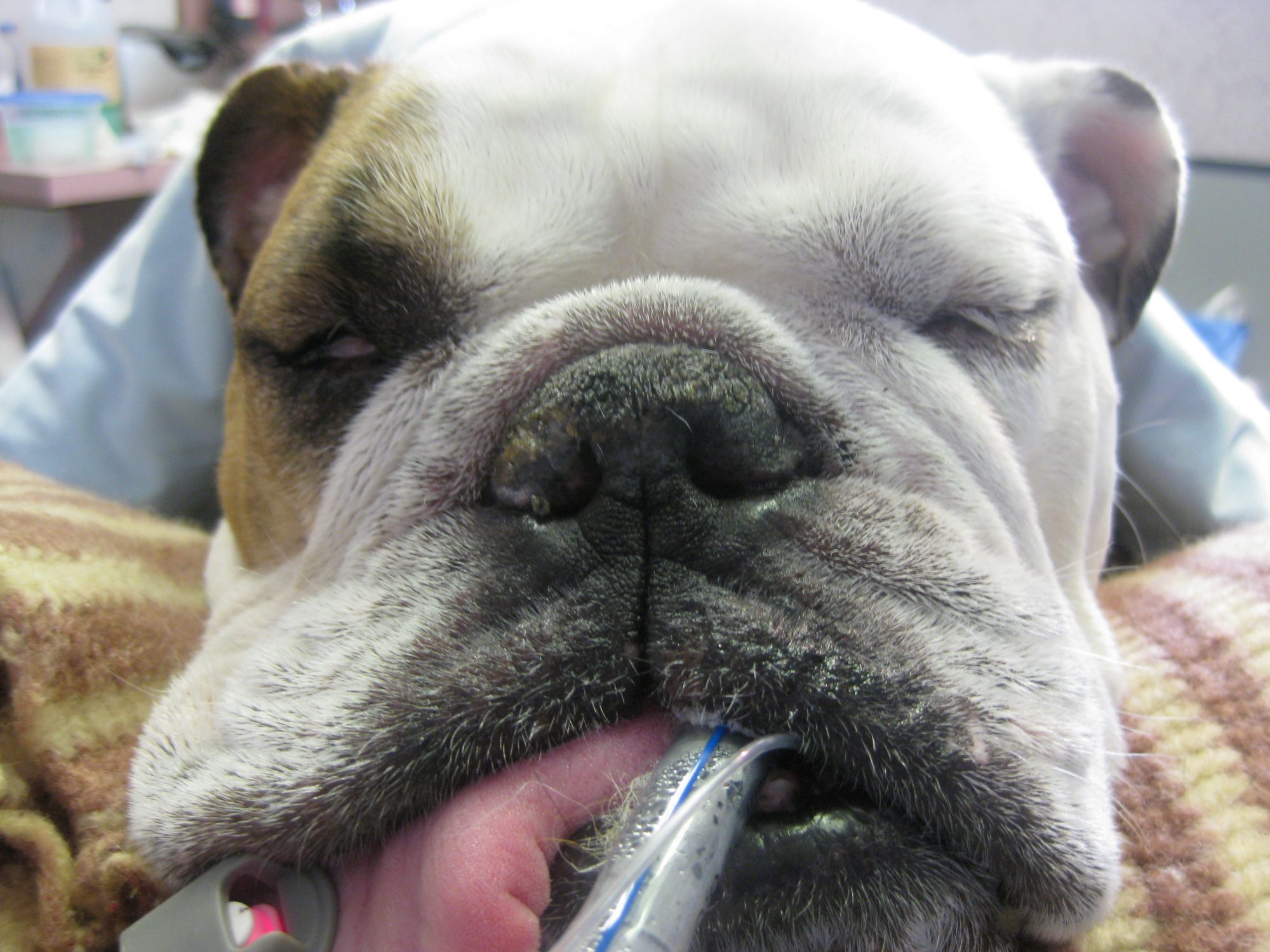
A Bulldog under anesthesia
Here are 5 common things we do around surgery time, and why we do them.
1. Why do we do blood work?
We perform preop blood work to make sure that the patient’s organs are healthy and functioning properly. We mostly look at the immune system, the red blood cells, the clotting system, the liver and the kidneys.
If one of these organs doesn’t work properly, it can dramatically affect the safety of anesthesia or surgery. In some cases, we may need to treat or “stabilize” the patient before we even consider surgery.
Many drugs are processed by the liver and the kidneys, so if they are not working well, the drugs will stay in the patient’s system for much longer than normal and could lead to complications such as a delayed recovery.
2. Why do we place an IV catheter?
We place an IV catheter for several reasons:
* To “stabilize” a patient before surgery, for example to correct abnormal electrolytes.
* To give a tranquilizer, before or after surgery.
* To give IV pain medications.
* To give IV antibiotics.
* To give IV fluids.
* To give IV emergency drugs if needed.
3. Why do we give IV fluids?
We give IV fluids for several reasons:
* To correct abnormal electrolytes (to increase or decrease them).
* To dilute some IV drugs.
* To make sure the patient is well hydrated.
* To make sure the blood pressure is high enough.
* To make sure we have easy access to a vein in case we need to give emergency drugs.
4. Why do we give IV antibiotics?
Under anesthesia, the patient’s immune system is weakened. Since neither the skin nor the air nor the environment is completely sterile, bacteria always end up in the surgical site. To prevent an infection, we give antibiotics before, during and after surgery.
Some organs are riskier than others: there are more, and more dangerous, bacteria in the intestine (think about removing a rock or a tennis ball from the intestine), than on the skin (think about removing a skin tumor).
5. Why do we give IV pain medications?
We give pain meds before anesthesia because it sedates or relaxes the patient. Interactions and minor procedures (e.g. placing an IV catheter or taking X-rays) are therefore less stressful.
In addition, it is better to give pain meds before the surgery starts because a smaller amount is needed. If we waited until the patient has been “stimulated” during surgery, we would need a bigger dose.
Ultimately, these 5 steps are designed to make anesthesia and surgery safer for your pet. This is our primary goal.
Phil Zeltzman, DVM, DACVS, CVJ, Fear Free Certified

Dr. Phil Zeltzman is a traveling veterinary surgeon in Pennsylvania & New Jersey. An award-winning author, he loves to share his adventures in practice along with information about vet medicine and surgery that can really help your pets. Dr. Zeltzman specializes in orthopedic, neurologic, cancer, and soft tissue surgeries for dogs, cats, and small exotics. By working with local family vets, he offers the best surgical care, safest anesthesia, and utmost pain management to all his patients. Sign up to get an email when he updates his blog, and follow him on Facebook, too!

